Sternocleidomastoid muscle
| Sternocleidomastoid | |
|---|---|
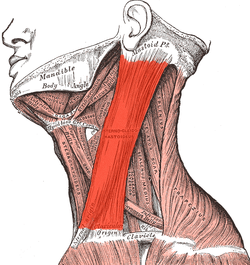 Muscles of the neck. Lateral view. | |
 The sternocleidomastoid muscle with nearby structures labeled, such as the triangles of the neck. | |
| Details | |
| Latin | Musculus sternocleidomastoideus |
| Manubrium sterni and medial portion of the clavicle | |
| Mastoid process of the temporal bone, superior nuchal line | |
| Occipital artery and the superior thyroid artery | |
|
Motor: accessory nerve sensory: cervical plexus | |
| Actions |
Unilaterally; cervical rotation to opposite side, cervical lateral flexion to same side Bilaterally; cervical flexion, raises the sternum and assists in forced inspiration. |
| Identifiers | |
| Gray's | p.390 |
| Dorlands /Elsevier | m_22/12550942 |
| TA | A04.2.01.008 |
| FMA | 13407 |
| Anatomical terms of muscle | |
In human anatomy, the sternocleidomastoid muscle (/ˌstɜrnɵˌkliːdɵˈmæstɔɪd/), also known as sternomastoid and commonly abbreviated as SCM, is a paired muscle in the superficial layers of the side of the neck. It is one of the largest and most superficial cervical muscles. The primary actions of the muscle are rotation of the head to the opposite side and flexion of the neck.
Structure
The sternocleidomastoid passes obliquely across the side of the neck. It is thick and narrow at its central part, but broader and thinner at either end.
- The medial or sternal head is a rounded fasciculus, tendinous in front, fleshy behind, which arises from the upper part of the anterior surface of the manubrium sterni, and is directed superiorly, laterally, and posteriorly.
- The lateral or clavicular head, composed of fleshy and aponeurotic fibers, arises from the superior border and anterior surface of the medial third of the clavicle; it is directed almost vertically upward.
The two heads are separated from one another at their origins by a triangular interval (supraclavicular fossa) but gradually blend, below the middle of the neck, into a thick, rounded muscle which is inserted, by a strong tendon, into the lateral surface of the mastoid process, from its apex to its superior border, and by a thin aponeurosis into the lateral half of the superior nuchal line of the occipital bone.
Innervation
The sternocleidomastoid is innervated by the ipsilateral accessory nerve. It supplies only motor fibres. The cervical plexus supplies sensation, including proprioception, via the ventral primary rami of C2 and C3.
Variations
The sternocleidomastoid varies much in the extent of its origin from the clavicle: in some cases the clavicular head may be as narrow as the sternal; in others it may be as much as 7.5 centimetres (3.0 in) in breadth.
When the clavicular origin is broad, it is occasionally subdivided into several slips, separated by narrow intervals. More rarely, the adjoining margins of the sternocleidomastoid and trapezius are in contact. This would leave no posterior triangle.
The supraclavicularis muscle arises from the manubrium behind the sternocleidomastoid and passes behind the sternocleidomastoid to the upper surface of the clavicle.
Relations
The sternocleidomastoid is within the investing fascia of the neck, along with the trapezius muscle, with which it shares its nerve supply (the accessory nerve). It is thick and thus serves as a primary muscular landmark of the neck during an extraoral examination of a patient since it divides the neck region into anterior and posterior cervical triangles which helps define the location of structures, such as the lymph nodes for the head and neck.[1] Anterior to sternocleidomastoid is the anterior triangle. Posterior to it is the posterior triangle.
Many important structures relate to the sternocleidomastoid, including the common carotid artery, accessory nerve, and brachial plexus.
Function
The function of this muscle is to rotate the head to the opposite side or obliquely rotate the head. It also flexes the neck. When acting together it flexes the neck and extends the head. When acting alone it rotates to the opposite side (contralaterally) and flexes laterally to the same side (ipsilaterally).
It also acts as an accessory muscle of inspiration, along with the scalene muscles of the neck.
History
Etymology
It is given the name sternocleidomastoid because it originates at the manubrium of the sternum (sterno-) and the clavicle (cleido-), and has an insertion at the mastoid process of the temporal bone of the skull.
Clinical significance
Examination
The SCM is effectively palpated on each side of the neck when the patient moves the head to the contralateral side.[1]
Society and culture
- In Tom Wolfe's novel The Bonfire of the Vanities, Larry Kramer, a Bronx District Attorney and one of the novel's main protagonists, prides himself on his strong sternocleidomastoids, which he "fans out" in front of women to help give himself a more tough, masculine appearance. However, in the last chapter he is publicly described by his client Maria Ruskin as "doing something weird with his neck", which deeply wounds his ego. Its use here is possibly a dramatic device signalling the lengths ambitious men go to, looking after every meticulous detail, in order to appear powerful, or how some women respond to such details and others not.
- Creature designers often include the sternocleidomastoid muscle in models of alien characters when they want them to seem attractive and familiar to human viewers due to the muscle's uniqueness as a mammalian feature. "Even C-3PO has it, in the form of little pistons on his neck. Watch Star Trek: The good guys always have them, and the bad guys don't. It's a classic alien designer trick," notes biologist and Hollywood anatomy consultant Stuart Sumida.[2]
- The famous Argentinian comedy/musical group Les Luthiers mention the sternocleidomastoid muscle in their song "El negro quiere bailar". The main actor (Daniel Rabinovich) is asked to move his sternocleidomastoid muscle as part of a dance class, but he erroneously interprets it as a pelvic/genital body part, and nervously covers himself with his arms.[3]
Additional images
-
Muscles connecting the upper extremity to the vertebral column. The posterior surface of the sternocleidomastoid muscle is labeled.
-

Position of sternocleidomastoid muscle. Animation.
-

Anterior surface of sternum and costal cartilages
-
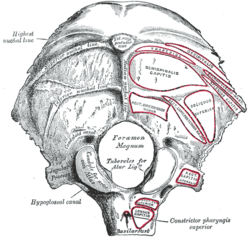
Occipital bone, outer surface
-

Left temporal bone, outer surface
-

Base of skull, inferior surface
-

Left clavicle, superior surface
-

Section of the neck at about the level of the sixth cervical vertebra
-
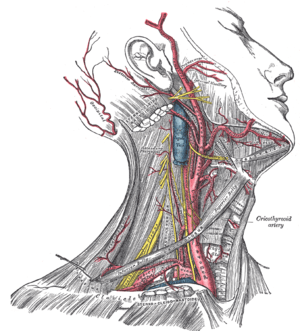
Superficial dissection of the right side of the neck, showing the carotid and subclavian arteries
-

Veins of the head and neck
-
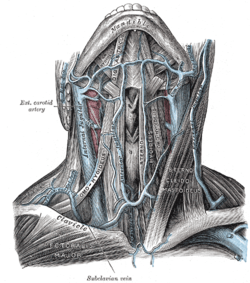
The veins of the neck, viewed from in front
-

The nerves of the scalp, face, and side of neck
-

Anterolateral view of head and neck
-
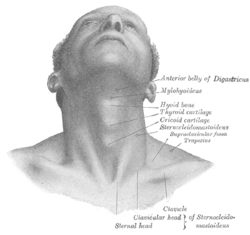
Front view of neck
-

surface anatomy
-
Sternocleidomastoid muscle
-
Sternocleidomastoid muscle, lateral view
-
SCM
-
SCM – right view
References
This article incorporates text in the public domain from the 20th edition of Gray's Anatomy (1918)
- ↑ 1.0 1.1 Illustrated Anatomy of the Head and Neck, Fehrenbach and Herring, Elsevier, 2012, page 87
- ↑ Nina Shen Rastogi (December 16, 2009). "On Na'vi Biology". Slate Magazine. The Washington Post Company. Retrieved December 21, 2009.
- ↑ Les Luthiers. "El negro quiere bailar (YouTube)".
See also
- This article uses anatomical terminology; for an overview, see anatomical terminology.
External links
| Wikimedia Commons has media related to Sternocleidomastoid muscles. |
- 436600910 at GPnotebook
- Anatomy figure: 24:01-03 at Human Anatomy Online, SUNY Downstate Medical Center
- ‹The template EMedicineDictionary is being considered for deletion.› Sternocleidomastoid+muscle at eMedicine Dictionary
- Anatomy diagram: 25420.000-1 at Roche Lexicon - illustrated navigator, Elsevier
| ||||||||||||||||||||||||||||||||||||||||||||||||




